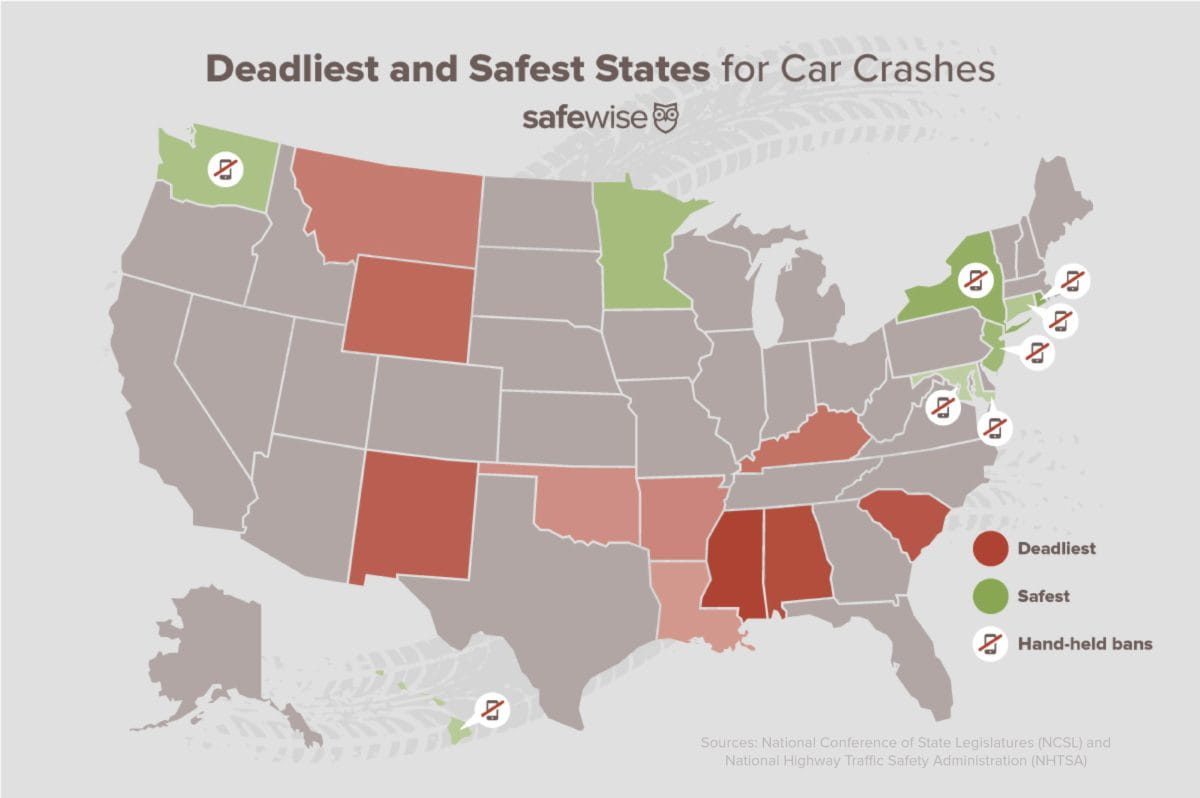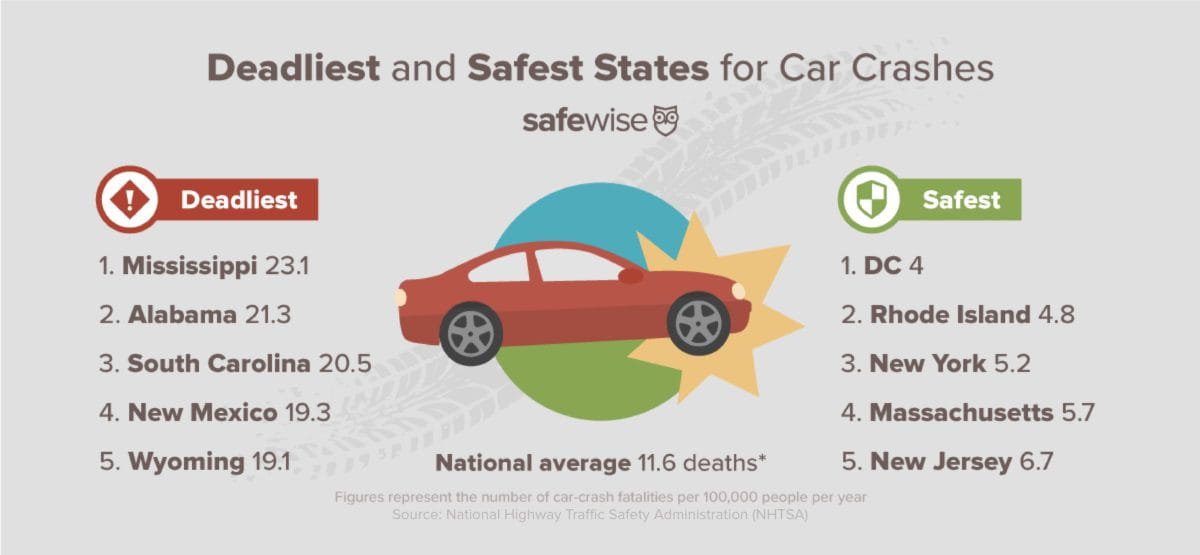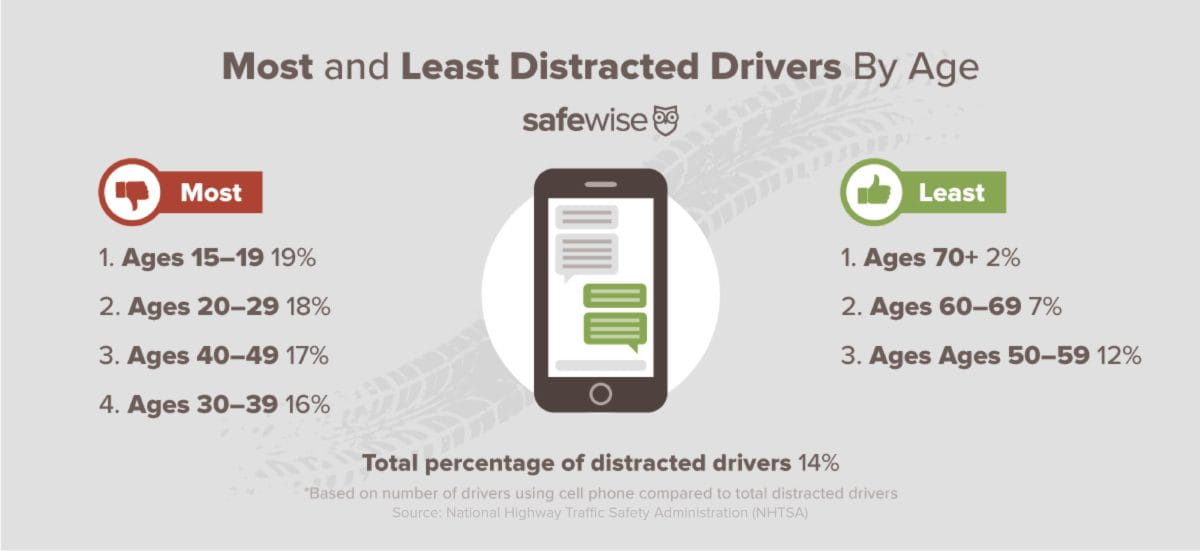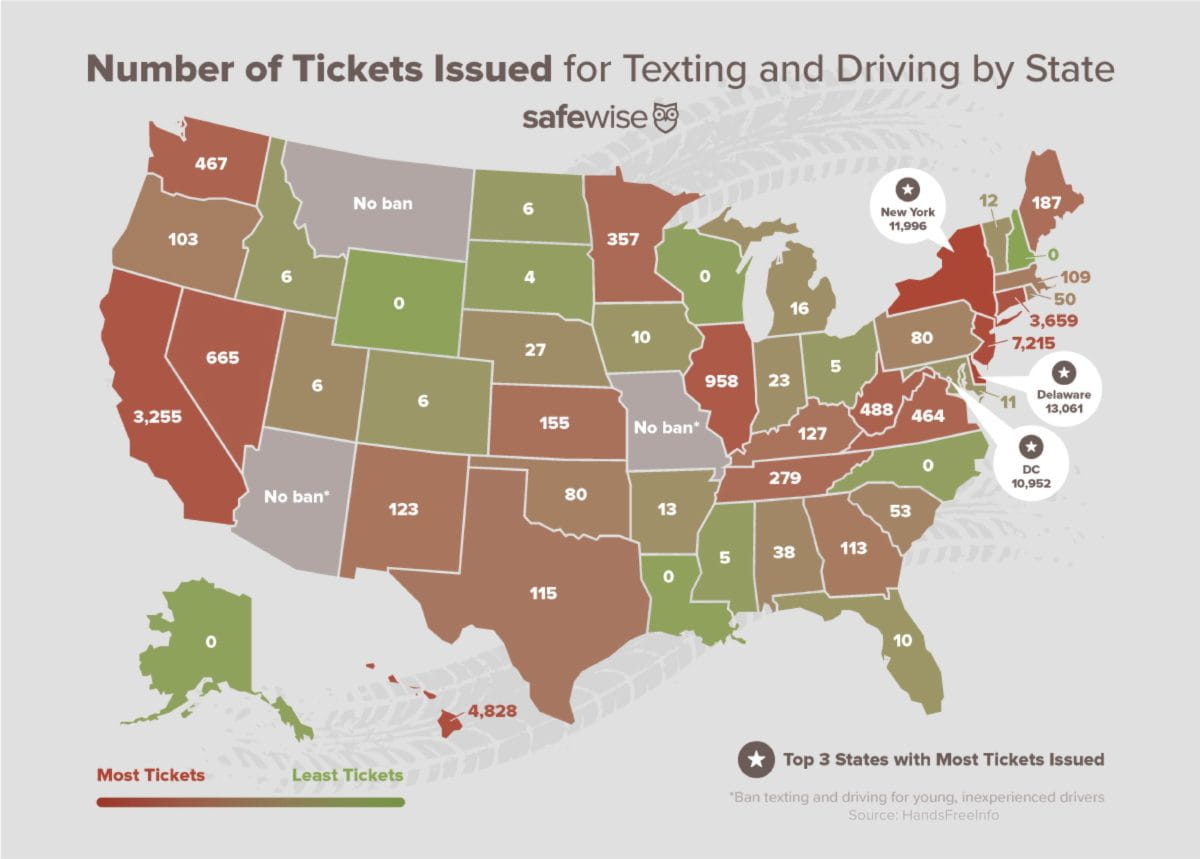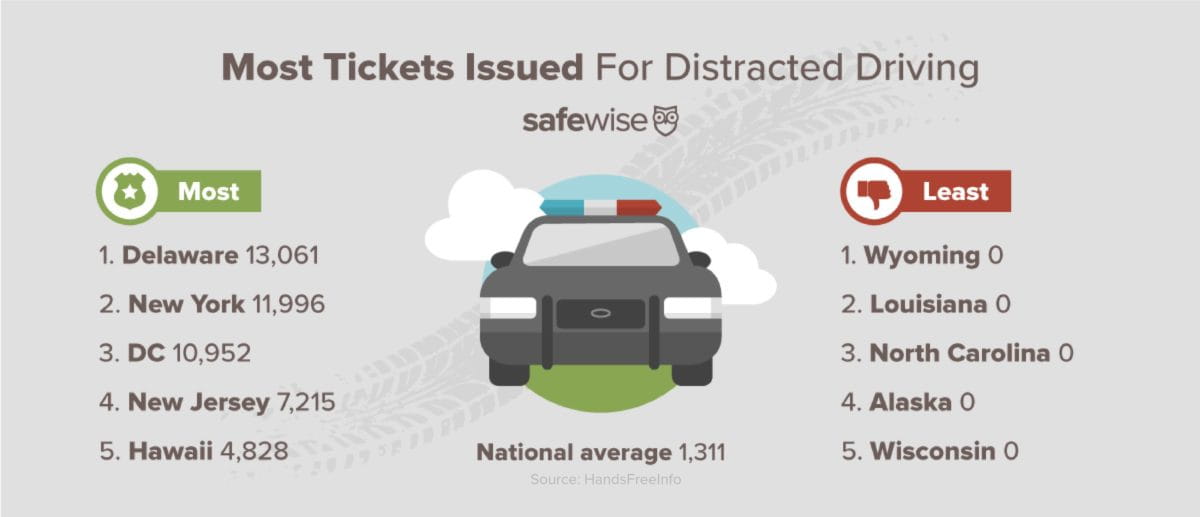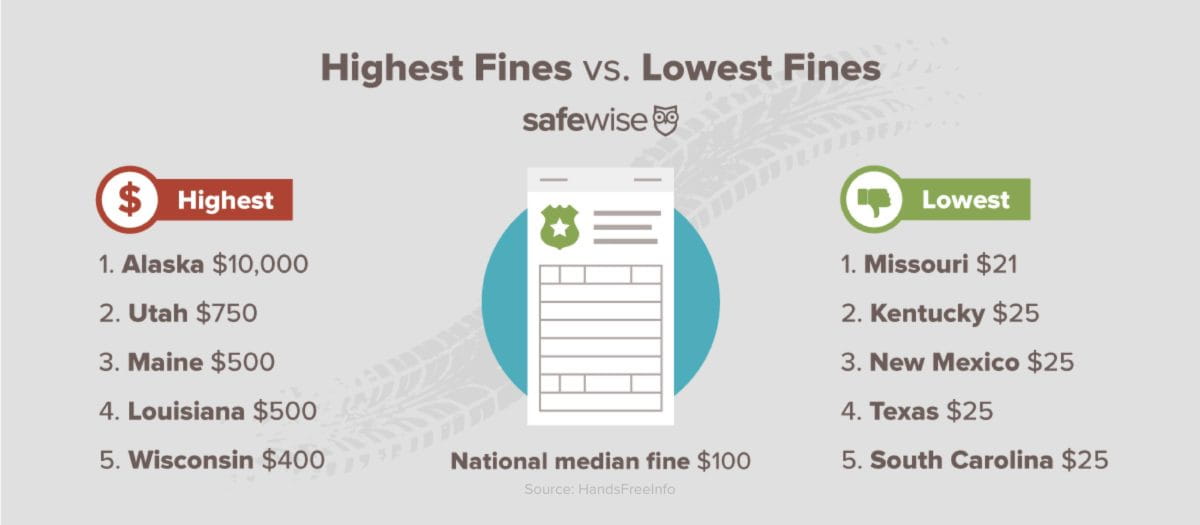The Safest and Deadliest States for Car Crashes
An article that originally appeared on the Safewise site https://www.safewise.com/blog/distracted-driving-by-state/
What are the chances you will die in a car crash? Or get pulled over for using your phone while driving?
The answer depends on which state you’re in. Each day in the US, over 1,000 people are injured and nine people are killed because of distracted drivers.1 While cellphones are not involved in all distracted driving, they are a serious problem that increases the risk of a crash.
Lawmakers in each state are addressing this issue in different ways. For example, even though no state bans all cellphone use for all drivers, fifteen states and the District of Columbia have banned all drivers from handheld phone use. Texting and driving is banned for all drivers in DC and all but three states.2
In honor of National Safety Month, we compiled this report to increase awareness of the dangers of driving distracted and encourage drivers to take the pledge to be a safe driver.

Total crashes caused by distracted driving, particularly from cellphone use, are thought to be much higher than the numbers below show.
The Dangers of Distracted Driving
While cellphones aren’t the only form of distracted driving, these devices are the most common distraction.3 From texting and talking to navigation and music, using your cellphone while driving your car is seriously dangerous.
It’s especially worrisome considering that it often uses all three forms of distraction—it visually takes your eyes off the road, manually takes your hands off the wheel, and cognitively requires thinking about something other than driving.
These worrisome facts about distracted driving come from the latest data (2016) released by the NHTSA :
- 6% of all drivers in fatal crashes were driving distracted.
- 37,461 people died in car crashes, an average of 102 people a day. That’s a 13% increase from 2014.
- 9% of fatal crashes were reported to involve distracted driving. That’s an increase of 17% since 2014.
- There were 562 pedestrians and bicyclists killed in distracted car crashes. That’s an alarming 9% increase from 2015.
- Drivers under the age of twenty are the largest group reported as distracted at the time of fatal crashes.
These additional facts highlight the dangers of distracted driving even more:
- It’s estimated that there are about 481,000 drivers on their phones while driving every day.4
- 42% of drivers admit to reading a text or email while driving.5
- As of 2010, distracted driving was estimated to cause nearly $40 billion in damages per year.6
- About 70% of drivers report using a cellphone while driving, despite knowing they have an increased risk of causing a crash.7
- 1 in 4 car crashes are estimated to involve cellphone use.8
- Texting while driving is equivalent to driving the length of a football field with your eyes closed.9
Deadliest States for Drivers
These are the top ten states with the most deaths from car crashes in 2016. Included are the state’s laws and fines on cellphone use while driving:
| Rank | States | Deaths per 100,000 Population | Statewide Handheld Ban | Texting Ban | Year of Enactment | Statewide Minimum Fine |
| 1 | Mississippi | 23.1 | No | Yes | 2015 | $100 |
| 2 | Alabama | 21.3 | No | Yes | 2012 | $25 |
| 3 | South Carolina | 20.5 | No | Yes | 2014 | $25 |
| 4 | New Mexico | 19.3 | No*** | Yes | 2014 | $25 |
| 5 | Wyoming | 19.1 | No | Yes | 2010 | $75 |
| 6 | Kentucky | 18.8 | No | Yes | 2010 | $25* |
| 7 | Montana | 18.2 | No | No*** | n/a | n/a |
| 8 | Arkansas | 18.2 | No** | Yes | 2009 | $250 |
| 9 | Oklahoma | 17.4 | No** | Yes | 2015 | $250 |
| 10 | Louisiana | 16.2 | No | Yes | 2008 | $500 |
*Plus points on driver’s license
**Not all drivers, only novice drivers or bus drivers
*** Some cities or counties have handheld bans, but not statewide
Only 15 states and DC ban all drivers from using handheld cellphones while driving. Hands-free cellphone use is still allowed in most cases, which is still considered a distraction.
Young Drivers
Thirty-eight states and DC have recognized the increased crash risk for young drivers and have banned all cellphone use by novice drivers, but only twenty states and DC prohibit it for school bus drivers responsible for the safety of dozens of young children.10
Enforcement of Distracted Driving Laws
Some local governments have taken matters into their own hands—when statewide bans haven’t been passed, some cities and counties have forbidden cellphone use while driving.
But enforcement of distracted driving laws varies widely from state to state—discouraging texting and driving in particular can be extremely challenging without a law banning handheld cellphone use.
Most Tickets
These are the top ten states with the best enforcement of cellphone bans. This information is based on tickets issued per licensed driver:
| Rank | States | Citations /100,000 Licensed Drivers | Minimum Fine | Handheld Ban | Year Enacted | Texting Ban | Year Enacted |
| 1 | Delaware*** | 13,061 | $100* | Yes | 2011 | Yes | 2011 |
| 2 | New York*** | 11,996 | $243* | Yes | 2001 | Yes | 2011 |
| 3 | DC | 10952 | $100 | Yes | 2004 | Yes | 2004 |
| 4 | New Jersey*** | 7,215 | $400 | Yes | 2008 | Yes | 2008 |
| 5 | Hawaii | 4,828 | $250 | Yes | 2013 | Yes | 2013 |
| 6 | Connecticut*** | 3,659 | $100 | Yes | 2005 | Yes | 2005 |
| 7 | California*** | 3,255 | $161 | Yes | 2008 | Yes | 2009 |
| 8 | Illinois | 958 | $75 | Yes | 2014 | Yes | 2010 |
| 9 | Nevada | 665 | $50** | Yes | 2012 | Yes | 2012 |
| 10 | West Virginia | 488 | $100 | Yes | 2013 | Yes | 2013 |
*Plus points on driver’s license
**Plus court fines
***Received first federal grants for enforcing distracted driving laws in 2011 and 2012.
*Based on total number of citations reported statewide per 100,000 licensed drivers from the time that state’s cellphone law went into effect through 2016.
**There was no statewide data reported for distracted driving citations issued in Alaska, Louisiana, North Carolina, New Hampshire and Wyoming. Arizona and Montana do not have current texting bans in place for all drivers.
Findings
Distracted Driving Deaths
- Mississippi, Alabama, and South Carolina are the top three states where you’re most likely to die in a car crash, and none of them have a statewide law banning handheld cellphone use.
- Washington DC, New York, and New Jersey are among the top five places where you’re least likely to die in a crash, and all have laws banning handheld cellphone while driving. While public transit may be a factor, these places also have some of the strictest and longest standing distracted driving laws in the country.
Penalties for Distracted Drivers
- New York, Virginia, and Nebraska will add three or more points to your license for texting and driving, which means your insurance rates could spike if you get a ticket.
- Alaska and Utah are the only states with texting bans that include jail time as a penalty for the first offense. They also have the highest fines at $10,000 and $750, respectively.
- All but four states with texting and driving bans have primary enforcement, which means you can get pulled over for texting and driving. Ohio, Florida, Nebraska, and South Dakota are the only states with secondary enforcement.
- All drivers can get pulled over for talking on their cellphone in these states: California, Connecticut, Delaware, DC, Hawaii, Illinois, Maryland, Nevada, New Hampshire, New Jersey, New York, Oregon, Rhode Island, Vermont, Washington, and West Virginia.
Enforcement of Distracted Driving Laws
- New York, Connecticut, Delaware and California should be congratulated for their enforcement of distracted driving laws. They are among the top ten safest states, were the first states to qualify for federal funding to crack down on drivers using cellphones, and are among the top ten states with the most tickets issued since their bans were put in place.
- Delaware is the strictest enforcer of distracted driving, with the most citations issued per licensed drivers in their state. Since Delaware’s ban went into effect in 2011, the state reported more tickets than DC and New York, who have had handheld cellphone bans in place since 2004 and 2001, respectively.
- Arizona, Montana, and Missouri are the only states left without a texting and driving ban for all drivers. Arizona and Missouri only have bans for young, inexperienced drivers.
- Three of the top ten deadliest states—Louisiana, Wyoming, and Mississippi—have the worst enforcement of distracted driving laws, with less than 100 tickets issued collectively over the three to ten years since their bans were passed.
- Five of the top ten deadliest states for car crashes have preemption laws that prohibit local jurisdictions from enacting their own distracted driving bans: Kentucky, Louisiana, Mississippi, Oklahoma, and South Carolina.
The Solution: It Starts with You
Be part of the solution and pledge to #justdrive.
While government and law enforcement play an important role in making and enforcing laws to keep us safe, changing our behavior as individuals is a key factor in creating lasting change that can save lives.
What motivates you? Fear? Protecting loved ones? Losing money? Jail time?
Regardless of the current laws in your state, don’t use electronic devices while you drive.
Use this report as motivation to help kick your cellphone addiction and put down your phone while you drive.
- Commit to yourself that you will not drive distracted
- Before you start your car, turn off your phone
- Put it out of reach so you won’t get tempted to use it
- Lead by example
- Pay attention
- Advocate for policies against distracted driving at your work
- Advocate for strict distracted driving laws in your city and state
- Encourage others to #justdrive
Distracted Driving FAQs
How many crashes are caused by distracted drivers?
- 16% of total crashes are distraction-affected, with 8% involving cellphones
- 10% of all fatal crashes are affected by distraction, with 14% involving cellphones
- 15% of all crashes involving injuries are affected by distraction, with 8% involving cellphones
How many people are killed by distracted driving?
- 9% of fatal crash deaths were caused by distraction
- 6% of all drivers involved in fatal crashes were reported as distracted at the time of the crash
- 9% of drivers 15 to 19 years old involved in fatal crashes were reported as distracted
How many people are injured by distracted driving?
- 17.5% of all injuries from car crashes are affected by distraction, with 8% involving cellphones
Is it illegal to read a text while driving?
- 48 out of 50 states + DC have texting bans in place
- Montana, Arizona, and Missouri are the only three states that do not currently have a texting-while-driving ban for all drivers
- Missouri has a texting ban only for young drivers under age 21
- Arizona has a texting ban only for novice drivers under age 18
How much does a ticket for texting and driving cost?
- The fines and enforcement vary widely from state to state
- The highest fine is $10,000 in Alaska; the lowest is $21 in Missouri
Can you go to jail if you text and drive?
- In some states, technically yes. In Utah and Alaska, the law says you can go to jail for one year for your first offense if cited. However, enforcement of distracted driving laws vary widely from state to state.
Methodology
Ranking
Deadliest and safest states were determined based on total car crash deaths per 100,000 people. States with the most distracted driving tickets were ranked based on the total number of statewide citations reported per 100,000 licensed drivers starting at the time that state’s law went into effect through 2016.
This information was compared to each state’s distracted driving laws and penalties. In order to get a more accurate picture of the likelihood of being in a fatal crash, and due to inconsistencies in reporting from state to state, we did not compare distraction-only car crash data on a state-by-state level.
Fatal Crash Data
Fatal crash data was compiled from the latest reports published by the National Highway Traffic Safety Administration (NHTSA) for 2016. NHTSA uses data from the Fatality Analysis Reporting System (FARS), which is a census of fatal crashes in the fifty States, the District of Columbia, and Puerto Rico (Puerto Rico is not included in US totals).
Distracted Driving Laws
Information on state-by-state distracted driving laws were compiled from several sources, including the Governors Highway Safety Association (GHSA), the Insurance Institute for Highway Safety (IIHS), the National Conference of State Legislatures (NCSL), and the Centers for Disease Control and Prevention.
Distracted Driving Tickets
Information on the number of distracted driving tickets was compiled from Hands Free Info.
Limitations of Data
There is a lack of consistent reporting on distracted driving from state to state, especially on the enforcement of distracted driving laws that are in place. Police crash reports vary across jurisdictions, thus creating potential inconsistencies in reporting.
According to the National Safety Council, distracted driving is under-reported and crash reports are incomplete; reports in twenty-six states lack fields to capture texting, and thirty-two states lack fields to record hands-free cellphone use. In addition, there are twenty-three crash factors identified that should be captured on police reports, yet no state is capturing all twenty-three. Kansas and Wisconsin include fourteen and Maryland, Kentucky, and Nebraska are each capturing five.
Sources
1. Insurance Institute for Highway Safety, “Distracted Driving”
2. Centers for Disease Control, “Distracted Driving”
3. National Highway Traffic Safety Administration, “The Economic and Societal Impact pf Motor Vehicle Crashes, 2010 (Revised)”
4. National Highway Traffic Safety Administration, “Distracted Driving”
5. AAA, “87% of Drivers Engage in Unsafe Behaviors While Behind the Wheel”
6. National Highway Traffic Safety Administration, “The Economic and Societal Impact of Motor Vehicle Crashes, 2010 (Revised)”
7. National Safety Council, “Technologies Can Reduce Cellphone Distracted Driving”
8. National Safety Council, “News Release: NSC Releases Latest Injury and Fatality Statistics and Trends”
9. National Highway Traffic Safety Administration, “Distracted Driving Consequences”
10. Centers for Disease Control, “Distracted Driving”
